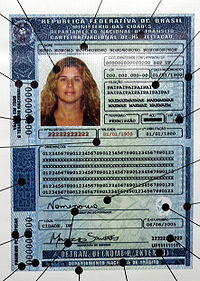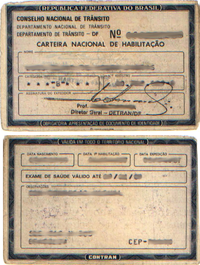- Driving licence in Brazil
-
In Brazil, a Driver's license (officially named Carteira Nacional de Habilitação, shortened as CNH and translated as "National Qualification Card") is required in order to drive cars, buses, trucks and motorcycles. Current CNHs can be used as identity cards in all the national territory.
It was formerly called PGU, but in 2008 CONTRAN (Conselho Nacional de Trânsito, translated as "National Transit Council") overhauled the system, requiring all driver's license holders to re-register, so they could be grouped in Renach (Registro Nacional de Condutores Habilitados, National Register of Qualified Drivers).
Minors, the illiterate and people without an ID card are not allowed to have a CNH.
Applicants must pass physical and psychological examinations before being authorized to start the required training. In the psychological examination, the applicant will be either approved or not approved. In the physical examination, the applicant can be approved, approved with restrictions or not approved. Being approved with restrictions means that the person can drive only under certain conditions. One common example is for people suffering from vision impairment, who are required to wear eyeglasses (or other correction mechanisms) while driving.
Contents
Required training
Until 2008, 20 hours of theory classes and 15 hours of practical classes were required in order to obtain a CNH. However, from 2009 on, a total of 45 hours of theory classes are required for all categories, these classes now covering the previously optional subjects such as Brazilian traffic law, defensive driving and first aid. After attending the classes, students are subjected to a 30-question test, and are approved if providing at least 21 correct answers. Finally, 20 hours of practical lessons must be taken, accompanied by an instructor from a certified driving school. After that, a road test must be taken. The test consists on demonstrating several driving skills such as good handling of a manual transmission, knowledge of the right-of-way laws and ability to parallel park.
Infractions
When a vehicle is spotted (either by a traffic agent, the police or an automated system such as a speeding radar) violating traffic regulations, its owner receives a notification by mail, including details of the violation like its nature and location, the amount due as fine, and proof if available, like pictures taken by radars. Fifteen days after this notification is received, the actual ticket is issued. During these 15 days, the owner can submit a form to inform the traffic authority if they weren't the one driving the car when the infraction was committed. For example, if Bob lends his car to Paul, and Paul commits an infraction, Bob will receive the notification. He then has to fill the form with Paul's license information, have Paul sign it and submit it to the traffic authority within 15 days. Then, all fines and other sanctions for that violation will be issued to Paul instead of Bob.
Traffic violations in Brazil issue points against the driver's license. Offenses are divided in four categories: "minor" (3 points), "medium" (4 points), "serious" (5 points) and "very serious" (7 points). The points for an infraction are considered for one year, starting at the day of the offense.
If at any time the total score passes 20 points (which means the driver has obtained more than 20 points within one year), the license will be suspended and the local traffic authority will notify the driver, which can enter a defense in the following sixty days. In any case, past these 60 days, the traffic authority will decide the duration of the suspension, which can be 1 to 24 months. Once the suspension period ends and the driver completes an "offender driver reeducation course", the suspension is terminated.
Temporary CNH
The first driving license is a 1 year permit. It is basically the same as a full-fledged license, but with some particularities regarding infractions and penalties. The permit may be revoked (instead of only suspended) in the case of committing any "very serious" or "serious" infraction, or two "medium" infractions. The 20 points system remains the same. Having their permit revoked, the driver must restart the entire process for acquiring a new permit.
Categories
CNHs are divided in five categories, according to the vehicles the driver is allowed to drive:[1]
- Category A – Two or three-wheeled motor vehicles, with or without a sidecar. This category is for motorcycle drivers.
- Category B – Any motor vehicle not in category A that weights up to 3,500 kg (~7,700 lb), can carry at most 8 people besides the driver, and has no articulation or trailer. This category is for all common cars up to vans, although in the latter, the passenger-carrying capacity has to be considered. Note that the law limits the capacity of the vehicle, not the actual number of passengers, so a driver with a category B license can not drive a van with more than 8 seats (9 with the driver's) even if none of the other seats are occupied. Traffic regulations forbid more than one passenger per seat and requires all passengers to be seated, except for buses, so this is a de facto limit on passengers too, although this regulation is rarely enforced.
- Category C – Same as category B, but without the weight limit. This category allows all vehicles in category B, in addition to rigid trucks.
- Category D – Same as category C, but without the passenger limit. This category allows all vehicles in category C, in addition to rigid buses (thus allowing all vehicles except motorcycles, semi trucks and articulated buses).
- Category E – Same as category D, but also allowing trailers (including semi trucks) and articulated buses. This category allows all street-legal vehicles with four wheels or more.
The requirements for each category are as follows:
- Categories A and B - The applicant must be at least 18 years old, be able to read and write (although not necessarily with proficiency) and have an ID card, in addition to being approved in physical and psychological examinations.
- Category C - The applicant must have a CNH of category B for at least a year.
- Category D - The applicant must be at least 21 years old and have a CNH of category B for at least two years or of category C for at least a year.
- Category E - The applicant must be at least 21 years old and have a CNH of category C or D for at least a year.
Additional requirements
Some types of vehicles or uses require additional training. The additional courses are:
- Emergency vehicles course - Required to drive emergency vehicles like ambulances or police cars.
- Public passenger transport course - Required to drive vehicles used in public transport, like urban public buses. Requires a CNH category D.
- School vehicles course - Required to drive vehicles used to transport students, such as school buses. Requires a CNH category D.
- Transportation of hazardous products course - Required to drive vehicles transporting hazardous materials, such as flammable, explosive, corrosive or radioactive substances, as well as substances that release hazardous materials when exposed to water, substances that can self-ignite, and any kind of poisonous substance. Requires a CNH category C.
The driver is not allowed to sign up for any of these courses if they committed a serious or very serious or more than one medium offense less than a year before or if their CNH is suspended.
References
External links
Driving licence in South America Sovereign states - Argentina
- Bolivia
- Brazil
- Chile
- Colombia
- Ecuador
- Guyana
- Panama
- Paraguay
- Peru
- Suriname
- Trinidad and Tobago
- Uruguay
- Venezuela
Dependencies and
other territories- Aruba
- Bonaire
- Curaçao
- Falkland Islands
- French Guiana
- Categories:
- Road transport in Brazil
- Driving licences by country
Wikimedia Foundation. 2010.
Look at other dictionaries:
Point system (driving) — A demerit point system is one in which a driver s licensing authority, police force, or other organization issues cumulative demerits, or points to drivers on conviction for road traffic offenses. Points may either be added or subtracted,… … Wikipedia
Drunk driving law by country — Contents 1 Laws by country Blood/Alcohol Limit 1.1 Asia 1.1.1 Central Asia … Wikipedia
List of countries by minimum driving age — This list refers to the minimum driving age for a motor vehicle with a maximum authorised mass not exceeding 3,500 and designed and constructed for the carriage of no more than eight passengers in addition to the driver (not including a trailer) … Wikipedia
International Driving Permit — An International Driving Permit (IDP) allows an individual to drive a private motor vehicle in another nation when accompanied by a valid license from their home country. The document is slightly larger than a standard passport and is essentially … Wikipedia
Mobile phones and driving safety — A driver placing a call Mobile phone use while driving is common, but dangerous. Due to the number of accidents that are related to cell phone use while driving, some jurisdictions have made the use of a cell phone while driving illegal. Others… … Wikipedia
Alan Brazil — Infobox Football biography playername = Alan Brazil fullname = Alan Bernard Brazil dateofbirth = birth date and age|1959|6|15 cityofbirth = Glasgow countryofbirth = Scotland dateofdeath = cityofdeath = height = nickname = position = Forward… … Wikipedia
Driver's license — Driving permit redirects here. In some countries, this term could also mean Learner s permit. The front side of an Austrian issue European driving licence with all the languages of the EU … Wikipedia
Identity document — National identity card redirects here. For cards referred to in the English language as national identity card , see National identity card (disambiguation). An identity document (also called a piece of identification or ID, or colloquially as… … Wikipedia
List of identity card policies by country — This is a list of identity documents by country.Identity card policies by countryCountries with compulsory identity cardsAccording to Privacy International, as of|1996|lc=on, around 100 countries had compulsory identity cards… … Wikipedia
Right- and left-hand traffic — countries with right hand traffic … Wikipedia


